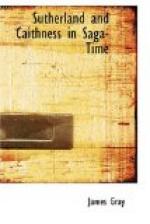It was in the reign of Constantine I, son of the great Pictish king, Angus MacFergus, that the new and disturbing influence mentioned above appeared in force in Alban. Favoured in their voyages to and fro by the prevailing winds, which then, as now, blew from the east in the spring and from the west later in the year, the Northmen, both Norsemen and Danes, neither being Christians, had, like their predecessors the Saxons and Angles and Frisians, for some time made trading voyages and desultory piratical attacks in summer-time on the coasts of Britain and Ireland, and probably many a short-lived settlement as well. But as these attacks and settlements are unrecorded in Cat, no account of them can be given.
In 793 it is on record that the Vikings first sacked Iona, originally the centre of Columban Christianity but then Romanised, and they repeated these raids on its shrine again and again within the next fifteen years. Constantine thereupon removed its clergy to Dunkeld, “and there set up in his own kingdom an ecclesiastical capital for Scots and Picts alike,"[1] as a step towards the political union of his realm, which Norse sea-power had completely severed from the original home of the Scots in Ulster.
The Northmen now began the systematic maritime invasions of our eastern and northern and western coasts and islands, which history has recorded. North Scotland was attacked almost exclusively by Norsemen, and Norsemen and Danes invaded Ireland. The Danes seized the south of Scotland, and the north of England, of which latter country, early in the eleventh century in the time of King Knut, they were destined to dominate two-thirds, while Old Norse became the lingua franca of his English kingdom, and enriched its language with hundreds of Norse words, and gave us many new place and personal names.
In 844, Kenneth, king of the Scots, the small North Irish sept which, as stated above, had crossed over from Erin and held the Dalriadic kingdom of Argyll with its capital at Dunadd near the modern Crinan Canal, succeeded in making good his title, on his mother’s side, to the Pictish crown by a successful attack from the west on the southern Picts[2] at the same time as their territory was being invaded from the east coast by the Danes. Thereafter, these Picts and the Scots gradually became and ever afterwards remained one nation, a course which suited both peoples as a safeguard not only against their foreign foes the Northmen, but also against the Berenicians of Lothian on the south. With the object of ensuring the union of the two peoples Kenneth is said to have transferred some of the relics of Columba, who had become the patron saint of both, from Iona to Dunkeld, which thus definitely remained not only the ecclesiastical capital of the united Picts and Scots, but the common centre of their religious sentiment and veneration. Incidentally, too, the Pictish language gradually became disused, as that people were absorbed in the




